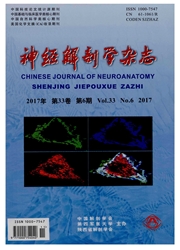

 中文摘要:
中文摘要:
P物质(SP)在中枢神经系统内具有镇痛作用,中脑导水管周围灰质(PAG)和中缝大核(NRM)是中枢内源性镇痛系统的关键结构。本研究采用顺行追踪与免疫组化双重染色相结合的三标方法,观察了起源于PAG的SP能阳性终末与NRM内SP受体(SPR)阳性神经元之间的突触联系。结果显示:将生物素化葡聚糖胺(BDA)注入小鼠PAG的腹外侧区后,BDA顺行标记终末可见于脑干的许多区域,但主要位于NRM。其中的部分BDA顺行标记终末呈SP阳性。NRM内可见到散在分布的SPR阳性神经元。在电镜下可见来自PAG的SWBDA双标终末与NRM内的SPR阳性神经元的胞体和树突形成以非对称性为主的突触联系。本研究的结果提示起源于PAG的下行投射终末所释放的SP是激活中枢内源性镇痛系统并使之发挥镇痛作用的重要神经活性物质。
 英文摘要:
英文摘要:
Substance P (SP) is mainly involved in the antinociceptive effects within the central nervous system (CNS). Both periaqueductal gray (PAG) and nucleus rapbe magnus (NRM) are fundamental structures for the endogenous pain control system in the CNS. In order to examine whether SP-ergic terminals originated from the PAG made synaptic connections with SP receptor IR) neurons in the NRM, the triple labeling method by employing antemgrede tracing combined with double ( SPR- staining for both SP and SPR was used in the present study. The results showed that after injecting biotinylated dextran amine (BDA) into the ventrulateral subregion of the mouse PAG, BDA anterogredely labeled fibers and terminals were found widely distributed in most structures of the brainstem, especially in the NRM. Some of the BDA-labeled fibers and terminals showing SP-immunopesitive staining were also observed. A few SPR-IR neurons were scattered in the NRM. Under the electron microscope, synaptic connections between SP/BDA doublelabeled terminal and SPR-IR neuronal cell bodies and dendrites were observed. Most of these synapses made by SP/BDA double-labeled terminal and SPR-IR neurons were asymmetric in form, The present results suggest that SP released from the descending axon terminals originated from the PAG might be one of the most important neural active substances which activate the endogenous pain control system and exert antinociceptive effects in the NRM.
 同期刊论文项目
同期刊论文项目
 同项目期刊论文
同项目期刊论文
 期刊信息
期刊信息
